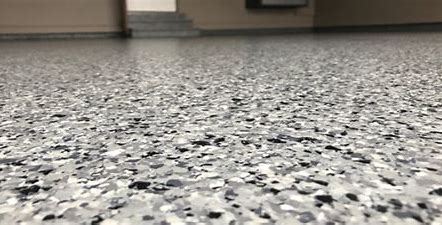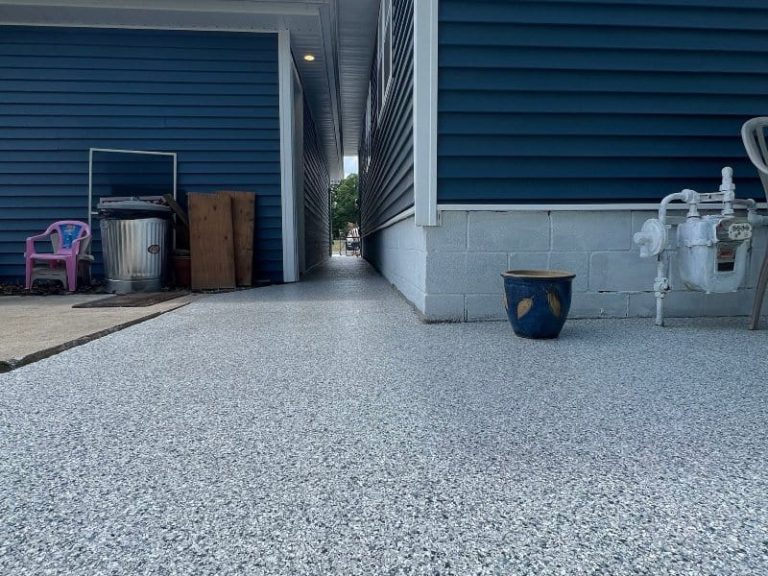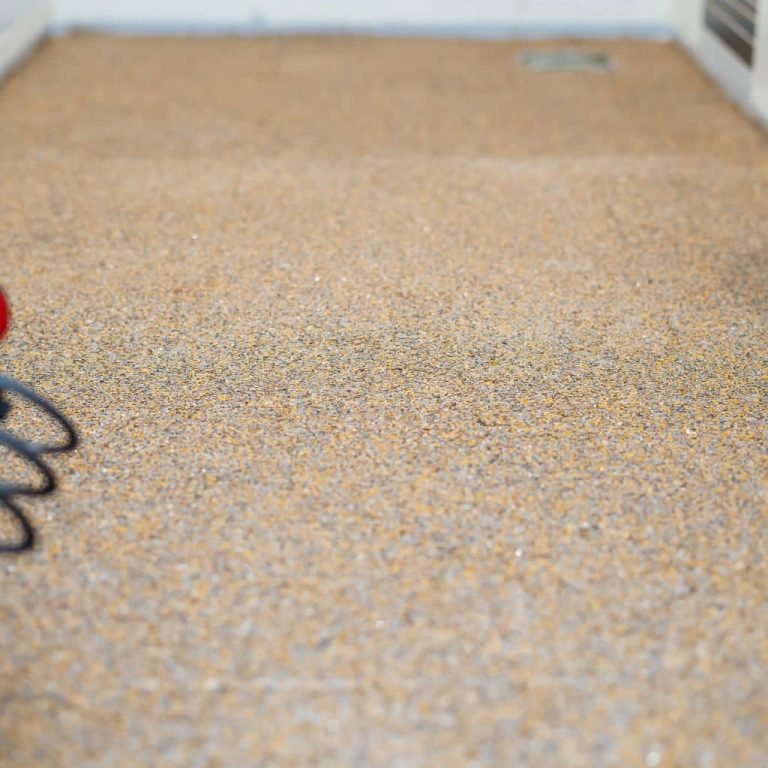Garage floors endure a surprising amount of wear and tear. From hot car tires rolling in day after day to regular exposure to dirt, moisture, spilled chemicals, and temperature swings, the concrete that supports your vehicles faces an array of potential pitfalls. That’s why many homeowners turn to specialized coatings, seeking a blend of protection, longevity, and aesthetic appeal.
But what about the budget? How do these coatings actually hold up in the long run? A recent interview with Crayton Caudill of Level 10 Coatings offers insights on typical costs for a 500-square-foot garage floor and explains why his team prefers polyurea-based coatings over traditional epoxy. If you’ve ever wondered how much you should spend, whether polyurea is truly worth the investment, or if it’s prone to cracking, read on.
Why Traditional Epoxy Isn’t Always the Go-To
In many conversations about garage floor coatings, epoxy reigns supreme as an older, well-known option. Yet despite its popularity, some professionals—including Caudill—choose to steer away from epoxy altogether. Why?
- Longer Curing Times: Epoxy coatings can take multiple days to cure fully, leaving your garage inaccessible for longer stretches.
- Rigidity and Cracking: Traditional epoxies are more rigid, which can lead to cracking or delamination when the underlying concrete expands, contracts, or slightly shifts.
- UV Sensitivity: Epoxy tends to yellow when exposed to direct sunlight, making it a less attractive choice for garages with windows, partial open-door exposure, or outdoor projects.
- Potential for Replacement: Because epoxy isn’t as durable over time, you may find yourself reapplying or even removing it to upgrade to a better coating—leading to double-spending down the road.
All these factors together have led many homeowners to seek alternatives that offer quicker cure times, higher flexibility, and a longer life span. Polyurea-based systems often check all these boxes.
The Cost of Coating a 500-Square-Foot Garage
In the snippet, a homeowner asks how much it costs to epoxy a 500-square-foot garage. Caudill responds by clarifying that he doesn’t work with epoxy—he focuses on higher-performance coatings—but notes that coating a 500-square-foot space generally ranges from $3,500 to $5,000, depending on several variables:
- Concrete Condition: If the slab is severely cracked, stained, or otherwise damaged, surface prep and repairs add cost.
- Verticals and Edges: Coating vertical surfaces (like the edges of steps or small walls) can slightly increase labor and material expenses.
- Additional Treatments: In high-moisture regions or areas with humidity issues, a moisture vapor barrier might be needed, which further raises the overall price.
- Color, Finish, or Decorative Flakes: Fancier designs or decorative chips may require more materials or multiple coats.
Keep in mind that $3,500 to $5,000 represents an average range for a professional polyurea system. If you were to apply a basic epoxy yourself, you might pay significantly less for the materials. However, the durability and longevity may also be drastically lower, which can cost you more in the long run—both in inconvenience and potentially in total expense.
Is Polyurea Worth the Money?
According to Caudill, polyurea is “definitely worth the investment if you’re looking to do things once and do it right.” This statement gets to the heart of the decision many homeowners face: Should they save on upfront costs by using epoxy, or pay more initially for a long-lasting solution like polyurea?
Long-Term Value
A quality polyurea or polyurea polyaspartic system typically lasts much longer than a comparable epoxy floor. Many coatings specialists cite a 20-year or more lifespan under normal usage. While epoxy might perform well for the first few years, it has a higher likelihood of peeling, chipping, or losing its gloss, especially if poorly installed or if the garage endures heavy usage. With polyurea, you minimize the likelihood of costly repairs or re-installations.
Removal Costs
Another factor Caudill points out is that if you end up unhappy with an epoxy floor—due to yellowing, cracking, or peeling—you’ll need to remove it before upgrading to a polyurea system. That removal process requires extra labor (grinding the old coating off), leading to more upfront expenses than if you’d chosen polyurea from the start.
Faster Curing Time
Polyurea often cures far faster than epoxy. In many cases, a professional crew can prep the slab, apply the product, and have the surface ready for light foot traffic in just hours, allowing you to regain full use of your garage in about a day. Epoxy can take multiple days to fully cure, impacting your daily routine.
Safety and Comfort
The advanced chemical makeup of polyurea can include slip-resistant additives, anti-microbial properties, or other custom features that enhance safety and cleanliness. Plus, because it maintains a stronger bond and uniform surface, you’re less likely to deal with trip hazards like peeling edges.
Will Polyurea Crack?
A common worry for anyone investing in a new floor is cracking. Concrete slabs expand and contract with temperature changes and moisture levels; if the floor coating is too rigid, it may split or separate over time. Caudill emphasizes that polyurea “does not crack very easily” because it’s far more flexible than standard epoxy.
Why Flexibility Matters
Think of the difference between a rigid plastic spoon and a silicone spatula. One snaps under pressure, while the other simply bends. Polyurea coatings work similarly: they can flex with minor shifts in the concrete. Since polyurea is often used on bridges—structures that experience significant load stress and environmental changes daily—it’s strong evidence that the material is engineered to tolerate movement without failing.
Reducing Concrete Damage
Coatings alone don’t fix underlying problems in your slab, such as major shifts in foundation or severe structural issues. A reputable contractor will fill large cracks, patch holes, and repair surface spalling before applying any coating. Once the coating is in place, its flexibility helps minimize additional damage, protecting your garage floor for years to come.
Practical Demonstrations
Caudill mentions that he often shows homeowners a side-by-side flexibility test when he meets them. The difference can be striking: bending a piece of cured epoxy versus a piece of cured polyurea quickly illustrates why one might be more prone to cracks than the other. If you’re still on the fence, consider asking your installer to demonstrate.
Additional Factors That Influence Cost and Value
Just like any home-improvement project, the decision to coat your garage floor doesn’t happen in a vacuum. You’ll want to consider the broader picture and how your new floor integrates with your goals, your property’s condition, and your lifestyle.
Garage Usage
If you use the garage strictly for parking and occasional storage, your demands on the floor might be moderate. But if you run a workshop or regularly park heavy machinery there, you’ll need a coating that withstands extra abuse. Polyurea’s durability could be well worth the added cost in these scenarios.
Existing Moisture
Moisture levels in your concrete can dramatically impact coating performance. If your slab rests on a poorly drained foundation or in a humid climate, a moisture vapor barrier may be necessary before applying any coating. This step raises overall costs but also protects you from adhesive failures down the road.
Appearance and Customization
Polyurea coatings are known for their glossy finish and the ability to add decorative chips or metallic accents. These visuals can elevate your garage from functional to showroom-worthy. If you have prized vehicles or want to impress potential buyers when selling your home, aesthetics matter.
Epoxy can also include decorative elements, but the color stability over time could be inferior—especially if you’re dealing with partial sun exposure.
Installer Expertise
Even the best products fail with poor installation. Check your prospective installer’s experience and credentials. Do they mechanically grind the floor to remove impurities and open the concrete pores before applying the coating? Are they prepared to handle crack repairs or significant spalling? A thorough prep job can be as important as the coating material itself.
Are Coated Floors an Investment in Home Value?
Some homeowners wonder if a new garage floor will boost their property’s resale value. While real estate professionals disagree on the exact figures, a pristine, durable floor can signal to buyers that the entire house is well-maintained. Many potential buyers dislike seeing cracked, damaged concrete, which can feel like a red flag—possibly hinting at deeper structural concerns or immediate post-purchase expenses.
With an upgraded floor, you reduce that anxiety and potentially differentiate your home in a competitive market. If nothing else, a finished floor often translates to faster sales and fewer buyer objections. And if you choose to stay in your home, you enjoy the long-term benefits of a garage floor that resists chemicals, moisture, and everyday wear, all while looking great.
Alternatives to Polyurea and Epoxy
If neither epoxy nor polyurea strikes your fancy, you do have other choices for your garage floor:
- Polyurethane Topcoats: A mid-tier solution sometimes used in tandem with epoxies or acrylic sealers. They can add UV protection, though they may not be as robust as polyurea.
- Concrete Stains and Seals: Less expensive than a full coating, but also offer limited protection.
- Floor Tiles or Mats: Snap-together tiles or roll-out mats can hide blemishes while adding grip. However, they can trap moisture beneath if not installed correctly, and they don’t bond to the concrete itself.
Each alternative has its pros and cons in terms of cost, durability, and appearance. Still, polyurea stands out as one of the most advanced, long-lasting options.
How to Choose the Right Contractor
Because the cost of a 500-square-foot project typically ranges between $3,500 and $5,000, you’ll want to ensure you’re hiring a reputable contractor. Here’s what to look for:
- Reviews and Testimonials: Read online reviews or seek word-of-mouth recommendations from neighbors, friends, or community forums.
- Detailed Quotes: A quality contractor should provide a transparent breakdown of costs, including surface prep, crack repairs, moisture barriers if required, and the specific coating system.
- Warranties: Many experienced installers back their work with warranties on both labor and materials. The length and scope of these warranties can give you confidence in the product’s longevity.
- Professional Equipment: Ask if they use diamond grinders or shot-blasters to prep the slab, and confirm they have commercial-grade vacuum systems to manage concrete dust.
The Process of Installing a Polyurea Floor
If you’re curious about how polyurea ends up on your garage floor, here’s a quick overview of the typical installation process:
- Inspection and Planning: The contractor evaluates the slab for cracks, moisture levels, and other vulnerabilities.
- Surface Preparation: Using diamond grinders or shot-blasters, the floor is roughed up to create a strong mechanical bond for the coating.
- Crack and Patching Work: Large cracks or spalling spots are filled and smoothed using patching compounds.
- Base Coat Application: The polyurea base coat is applied, chemically bonding with the prepared concrete.
- Chip Broadcast (Optional): Decorative vinyl flakes can be broadcast onto the wet coating for texture and style.
- Scrape and Clean: Once cured, the excess chips are scraped and removed, ensuring a uniform surface.
- Top Coat Application: A polyaspartic or polyurea top coat provides UV stability, gloss, and chemical resistance. The result is a sleek, durable finish that’s often ready for light foot traffic within hours.
Making the Decision: Epoxy, Polyurea, or Something Else?
Budget is a big factor in any home improvement project. You might think an epoxy kit from a home improvement store is appealingly cheap, but consider whether you’re prepared for shorter lifespans or possibly re-coating. If you’re the type of homeowner who prefers to do it once and forget about it, investing in polyurea may be the better path, even if the cost is higher initially.
If you’re still on the fence, weigh these questions:
- How long do you plan to live in this house? A short-term homeowner might be okay with epoxy, while a long-term homeowner likely benefits more from the reliability of polyurea.
- How important is your garage? If you see it as a mere parking spot, you might not invest heavily in upgrades. But if it’s a workshop, hobby space, or a potential selling point for car enthusiasts, a premier coating can pay dividends.
- Do you like a clean, finished look year-round? Polyurea’s resistance to salt, oil, and other contaminants reduces the time you’ll spend cleaning, which might be reason enough to upgrade.
- Are you worried about cracking? If you have reason to believe your concrete sees big temperature swings or slight shifting, polyurea’s flexibility gives you extra peace of mind.
Conclusion
Choosing the right garage floor coating comes down to balancing cost, longevity, appearance, and installation practicality. Epoxy may be cheaper on paper, but in the long run—especially if you’re dealing with re-coats, removal, or persistent cracking—the total expense can exceed that of a high-quality polyurea coating. And since polyurea offers faster cure times, greater flexibility, and top-notch durability, it’s often the favored solution for homeowners seeking a “do it once, do it right” philosophy.
Ultimately, the $3,500 to $5,000 price tag for a 500-square-foot garage floor (depending on the slab condition and other variables) can be a worthy investment. It transforms your garage from a dingy afterthought into a polished, functional extension of your home—ready to handle everyday use, resist chemicals, shrug off moisture, and remain crack-free for decades.


